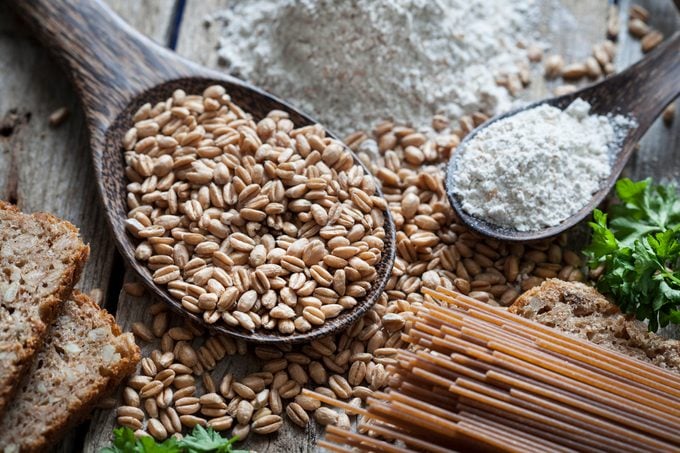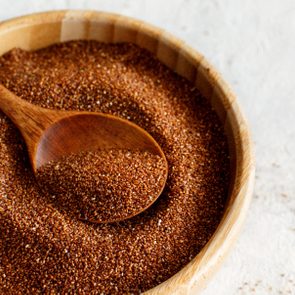Is Spelt Good for You? What to Know About This Ancient Whole Grain
Updated: Mar. 30, 2022
Spelt is an ancient grain that is similar in nutrition to wheat with plenty of carbs, protein, and fiber. Learn about its benefits, plus how to eat it.
What is spelt?
Spelt is considered an ancient grain and has been making an appearance in small bakeries dedicated to the craft as well as in the kitchens of chefs and home bakers.
You’ll find bread, muffins, and even cookies made with spelt flour because it offers variety, texture, and a sweet, nutty flavor.
One of the reasons wheat has been more popular and more readily available than spelt is wheat is easier to process on a mass scale. That’s because the proteins in spelt don’t do as well with large-scale production.
But family farmers or smaller organic farmers are more likely to grow spelt and sell directly to artisan bakers or to home chefs and bakers, which has helped put more focus on this ancient grain in the United States.
“Spelt is a whole wheat, which can be considered more nutritious than refined wheat, since it contains more protein, fiber, and contains many essential nutrients like iron, magnesium, and zinc,” says California-based registered dietitian and nutrition consultant Danielle Gaffen.
Spelt nutrition facts
Spelt packs a lot of nutrition.
“It’s pretty high in fiber, 7.6 grams per cup, and is a fair source of phosphorous, magnesium, zinc, and iron—it’s very similar to wheat,” says Vanessa Rissetto, RD, and co-founder of Culina Health.
Here are the nutritional benefits of one cup of cooked spelt (194 grams) and the percent Daily Value (DV):
Calories: 246
Carbs: 51 g (19 percent DV)
Protein: 11 g (22 percent DV)
Fat: 1.7 g (2 percent DV)
Sodium: 9.7 mg (0 percent DV)
Fiber: 7.6 g (27 percent DV)
Calcium: 19.4 mg (1 percent DV)
Iron: 3.2 mg (18 percent DV)
Magnesium: 95.1 mg (24 percent DV)
Manganese: 2.2 mg (92 percent DV)
Vitamin B3 (niacin): 5 mg (31 percent DV)
Phosphorous: 291 mg (23 percent DV)
Potassium: 277 mg (6 percent DV)
Zinc: 2.4 mg (22 percent DV)
Origins of spelt
Spelt originated in Europe and is thought to have been cultivated for several thousand years dating as far back to 5000 B.C.
Europeans brought spelt to the United States in the 1800s but after almost a century of growing this grain, around the 1920s, common wheat became more typical to grow because the process was easier to mechanize.
Spelt requires more care and can be more labor-intensive because the grain must be dehulled before grinding into a flour.
Spelt is becoming more widely available in the United States, thanks to many farmers having an interest in cultivating this grain and plenty of interest from consumers to incorporate more varied foods into their diets.
Meanwhile, spelt is a culinary staple in Germany and is integrated in the cuisine, especially in bakeries where buying a loaf of spelt bread is typical.
(Find out what’s the healthiest bread to eat.)
Varieties
Spelt, or it’s Latin name, Triticum spelta, is classified as a type of wheat. Spelt is considered to be an older variety or version of common wheat, the wheat typically used in bread and easily found at the grocery store.
There are different types of spelt varieties and farmers and scientists are studying the different species to see how well they grow, especially in harsh cold winter climates. Spelt has similarities to other types of wheat varieties, such as einkorn or kamut.
Like other wheat, spelt is a type of grass that is part of the Poaceae family. Spelt lends itself to growing in challenging climates and is considered a more resistant crop than common wheat.
Family farmers and/or small-scale farmers, who practice organic methods, often prefer cultivating this grass because it thrives in difficult circumstances and more importantly, is capable of resisting pests naturally without the need to use toxic pesticides.

Health benefits of spelt
Spelt is packed with nutritious components that are good for our bodies.
“Spelt is a worthwhile grain to incorporate in one’s diet as it contains a high protein and fiber content, which has a whole host of benefits,” says Rachel Naar, an RD and nutrition consultant in New York City.
Packed with fiber
The benefits of a high fiber diet are plentiful. Eating foods rich in fiber can help you feel full longer.
“Soluble fiber can also help with weight management by helping to maintain good levels of fullness until your next meal,” says Rissetto.
Fiber can also help with blood sugar levels by reducing spikes.
“The high fiber content helps lower high levels of LDL [low-density lipoprotein] cholesterol and can regulate insulin and glucose in the body aka good blood sugar stabilization aka mood stability,” explains Naar.
Plus, fiber aids in digestion and keeps the digestive tract healthy.
“Fiber also controls blood glucose levels and maintains healthy bowel function,” says Rissetto.
Fiber helps the heart, too.
“Studies also have shown that high-fiber foods may have other heart-health benefits, such as reducing blood pressure and inflammation,” says Rissetto. (These are the foods with more fiber than broccoli.)
Can help lower cholesterol
Eating spelt can be beneficial for cholesterol levels. Because spelt has a lot of fiber, it can minimize the effect of cholesterol.
“Due to spelt’s soluble fiber content, it may reduce the amount of cholesterol that the body absorbs into the bloodstream,” says Gaffen.
The fiber found in spelt is believed to help lower total blood cholesterol levels by lowering low-density lipoprotein, or “bad,” cholesterol levels.
Beneficial for heart health
Fiber helps lower cholesterol and directly affects the heart.
“The high fiber content of spelt aides in lowering high levels of LDL cholesterol. This reduces the risk of heart attacks, cardiovascular disease, and coronary heart disease as well,” says Naar.
Consuming fiber-rich foods is important for heart health. “Overall, people who eat more whole grains and fiber tend to have a lower risk of heart disease,” says Gaffen.
Conditions it might help control or reduce
Like other high fiber whole grains, spelt’s nutritional benefits may reduce or help some health conditions.
“Eating whole grains like spelt may reduce hypertension, improve digestion, assist with weight management, and reduce the risk of [type 2] diabetes (due to the fiber content) too,” says Gaffen.
Risks or side effects
It contains antinutrients
Spelt is a whole grain that may be beneficial to incorporate into your meals. But it’s important to be aware of a few things.
It contains antinutrients, which are compounds that reduce or block the absorption of nutrients. Antinutrients are common in plant-based foods and are also found in amaranth, millet, and teff.
Antinutrients for spelt include lectins and phytic acid.
“Lectins have been linked to digestive problems and autoimmune diseases, but most are destroyed in the cooking and processing of the grain,” Naar says.
However, antinutrients are typically something you don’t have to be concerned about. Rissetto says, [antinutrients] aren’t a problem for most people—just if you are malnourished or only base your diet on grains and legumes.”
It contains gluten
Because spelt is a type of wheat, it does contain gluten. People who have gluten intolerances, wheat allergies or celiac disease will want to avoid eating spelt.
Naar says spelt “can cause problems for people who are gluten intolerant (celiac disease or non-celiac gluten sensitivity) and trigger inflammation and/or digestive problems.”
It has FODMAPs
People who suffer from irritable bowel syndrome (IBS) may also want to limit their intake or avoid spelt altogether.
This is because spelt has FODMAPs—types of carbohydrates that occur in specific foods, such as beans and wheat. FODMAP is short for fermentable oligosaccharides, disaccharides, monosaccharides, and polyols are short-chain carbohydrates.
“Spelt contains a high amount of FODMAPs, which can trigger those IBS symptoms in specific people,” says Naar.
How to eat spelt
Spelt tastes slightly sweet and nutty. You can cook it and eat it in a variety of ways throughout the day.
“You could prepare it like risotto, use it as a base for a grain salad, add it to soups and stews, and make pasta with it. It can also be used as a breakfast cereal or side dish,” says Gaffen.
It’s also possible to use spelt as a substitute for rice, pasta or other grains. It’s also important to remember to rinse spelt before using it.
“Like other grains, rinsing spelt well before cooking with it is recommended to remove debris and unwanted residue,” explains Gaffen.
If you want to create more diversity with your meals and what you eat, spelt can be a fun option.
“Spelt provides us with more variety and an opportunity to incorporate a nutritious and delicious grain into our eating plan,” says Gaffen.
How to bake with spelt flour
You can also use spelt as a flour when it comes to baking.
“Spelt flour can be used to make bread, pancakes, cookies, or even a pie shell,” explains Gaffen.
Naar suggests using spelt flour as a substitute for half wheat flour in bread recipes or to thicken sauces and gravy.
Spelt flour can be a great way to add more nutrition to your baked goods. But it’s important to remember that it will have slightly different results due to its composition.
“If substituting spelt flour for refined wheat flour, be aware that spelt will create a richer taste and denser texture,” Gaffen says. “It may also absorb more water.”
But keep in mind that spelt isn’t necessarily a grain that will reduce time in the kitchen. In fact, preparing can take longer because it’s recommended that you take an extra step before cooking it.
Gaffen says, it can “take a bit longer to cook than other whole grains, and benefit from an overnight soak before cooking (this makes them easier to cook and digest).”
Try Fluffy Whole Wheat Biscuits with spelt flour or Ezekiel bread made with sprouted spelt.























